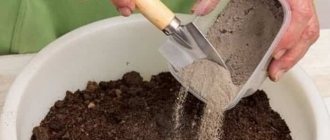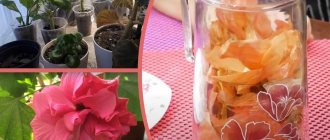Good afternoon, my reader. You can use homemade products to care for indoor plants. Garlic infusion is considered one of the most effective. This liquid has a lot of indications. If you prepare it correctly and process the flowers, you can strengthen the root system and make flowering more luxuriant. In addition, water infused with garlic has disinfecting properties and helps resist pests.
Using garlic water (Photo used under standard license ©azbukaogorodnika.ru)
Benefits and harms of use
The unique natural composition of garlic allows it to be used not only for culinary and health purposes, but also as a universal fertilizer for indoor and garden plants.
The main thing you need to understand is that the positive effect of the infusion is possible only if certain concentrations of the solution and frequency of watering are observed.
Almost all of the compounds found in garlic will benefit houseplants, but only in moderation.
The main positive impacts include:
Strengthening the root system, stimulating growth and increasing the number of inflorescences, as well as the general improvement of the plant in terms of key indicators.
This effect occurs with the systemic use of garlic water, which contains important microelements.For example, iron, potassium, phosphorus, potassium, magnesium, calcium. There is manganese and selenium, acids, antioxidants,
- Pest prevention or control. The specific smell, formed due to the presence of essential oils in the composition, helps to destroy pests. The insects do not disappear immediately, but after the first spraying the results are noticeable.
- Antiseptic effect. Using garlic water to water indoor plants, you can carry out antibacterial treatment of the soil and plant surfaces. Due to phytoncides, in particular allicin, bacteria and viruses are destroyed. Thanks to the action of these organic compounds, it becomes possible to get rid of mold and fungi.
How beneficial the use of garlic water will be depends on the method of preparing the solution and the frequency of watering.
If in moderate amounts the compounds contained in garlic water benefit indoor plants, then in excess they can be harmful .
Active substances, such as those contained in essential oils and other organic substances, can cause burns. This applies to the root system, as well as foliage and inflorescences, if irrigation is carried out.
In order not to harm the plants, you need to familiarize yourself with the proportions of preparing the solution. You should find out if there are any contraindications for use and, based on the recommendations, decide on the frequency of watering.
Beneficial properties of garlic water
The properties of garlic are undeniable; everyone knows about its positive effect on any living organism. The cloves release their phytoncides and vitamins, as well as antioxidants and minerals, into the infusion. With the help of proper watering, you can prevent infection of indoor plants, cure them, and also disinfect the substrate in the pot. But at the same time, it is important to observe the condition of which flowers can be watered with garlic water and which cannot.
Useful properties of the composition:
- Phytoncides in garlic water kill viruses, fungi and bacteria, and also prevent their occurrence. Timely watering will repel pests, which allows you to successfully use the composition even in open ground.
- Stimulation and restoration of plants, systematic processing will lead to thickening of the root system, leaves become larger, new ones grow, and more flower stalks are formed.
- Watering indoor plants in spring allows them to “wake up” faster after winter hibernation and enter the active flowering phase.
You can get the positive effect of garlic water if you maintain the technology of the composition, as well as with its proper use.
Contraindications for use
Garlic water treatment, although considered safe for plants, has some limitations. These include:
Using a high concentration solution. This is evidenced by a particularly pungent odor, as well as an initially significant deviation from the proportions during the cooking process.- Formation of buds, active flowering. During this period, the likelihood of damage to plants from irrigating them with garlic water increases, since the content of active compounds in the solution can lead to burns.
- Unnatural smell of the solution, signs of deterioration (bubbles, foam, mold).
Contraindications should be taken into account so that the treatment actually becomes useful and does not lead to damage or death of plants.
Watering orchids with garlic: why and how?
In addition to the above beneficial substances, garlic contains organic acids, mineral salts, and antioxidants . All of them are in a biologically accessible form for plants, easily absorbed by the root system, stems and leaves in any form, regardless of processing and feeding methods.
A high concentration of vitamins, volatile essential compounds, and phytoncides
has the following effect on home flowers :
- antiviral;
- antifungal;
- disinfectant;
- antimicrobial;
- strengthens the immune system;
- stimulates growth;
- effectively fights harmful insects.
Therefore, the use of garlic is necessary when caring for home orchids.
Garlic for orchids can be used periodically even for preventive purposes. It is even more necessary to feed the plant with garlic if you notice the following unpleasant phenomena occurring with the flower:
- The orchid does not bloom for a long time . The plant may feel good, not get sick, actively develop, form new leaves, but flower stalks do not appear. Watering with garlic solution will be an excellent incentive for the emergence of new flower stalks;
- Unwanted harmful insects, midges, appeared in the orchid pot . They leave flower pots very quickly and for a long time. Even if one clove of garlic is placed shallowly in the substrate, after a few hours all the midges around the plant will disappear;
Treatment with garlic water will rid the orchid of pests.
Please note that this method can be used at any time of the year, but some circumstances should be taken into account:
- Garlic infusion should be watered once every two weeks;
- be sure to alternate this method with regular watering;
- monitor the freshness of the garlic solution by replacing it with a new one in time;
- strictly follow the recipe, an overdose threatens death for the capricious orchid.
What to avoid when processing:
- This method cannot be used during flowering and dormant periods;
- garlic water cannot be used to spray flowers, otherwise the buds and petals may die;
- do not use this method to immerse roots during flowering;
- You cannot use the tincture more than twice.
If all recommended conditions are correctly met, the orchid will produce a new peduncle within two weeks.
How to cook?
To prepare a nutrient solution for plants, you need to stock up on the main ingredient - garlic. Any bulbs will do, as long as they are not spoiled.
Depending on the main purpose, for example, whether the suspension is intended for fertilizer or pest control, the proportions may vary.
Using the example of a quick solution for preventive watering of plants, let’s consider the algorithm for preparing garlic water:
the main ingredient is purified, the weight should be 200 g of raw materials without husks;- the garlic is finely chopped, it is better to use auxiliary devices to save time, a mushy consistency is required;
- the mixture is poured with a liter of boiling water and closed loosely;
- the solution is infused for 40-60 minutes.
- strain.
Since you cannot use up the entire solution at once, because 3-4 tbsp are pre-diluted. per liter of water, then the remains should be removed in a dark, cool place.
Other ready-made biological pest control products at home
Diatomaceous earth is a powder containing about 80-90% silica, formed from the fossilized shells of diatoms. Many people use diatomaceous earth as a natural insecticide. It can harm the exoskeleton of insects, causing them to dehydrate and die (while it remains completely safe for people and animals). Diatomaceous earth is effective in controlling ants. Just sprinkle some powder around the plants and the problem will soon be solved.
Neem oil
Neem oil is a preparation based on natural seed oil of the Neem tree, Azadirachta indica. The product is suitable for controlling ticks and insect pests (spider mites, thrips, whiteflies, scale insects and false scale insects, etc.). Azadirachtin affects them at the hormonal level, disrupting the life cycle and biological processes. Not suitable for processing herbs and grains. It is quite expensive, so it makes sense to purchase it to take care of your valuable collection.
To control flying pests and mosquitoes, there is no better option than a paper sticky trap. Everything ingenious is simple.
How to use?
The purpose of the solution may differ, which will affect the preparation recipe, proportions and methods of use. These features must be taken into account to obtain the desired effect.
From pests
You won’t be able to get rid of insects in one go , and you can’t use the solution often. That is why the concentration of the infusion should be low.
Take a head of garlic per liter of water (boiling water) and chop it. You need to insist for 5-7 days. Before use, dilute - 3-4 tbsp. for 10 liters of water.
Treatment is carried out by irrigating plant surfaces. Frequency 1-2 times a week. The infusion is diluted before use.
Like an antiseptic
To prepare the solution as an antiseptic, it is allowed to use not only the bulbs, but also the upper parts .
The main thing: clean all the raw materials from dirt, grind them and measure out 100 g. A liter of (warm) water is enough for this amount.
It is recommended to infuse the mixture for at least a day. Use no more than 1-2 times per month.
Like fertilizer
To feed the plant, garlic water is prepared as follows:
- 3 cloves (medium) are crushed into a paste;
- 3 liters of hot water is mixed with the main ingredient;
- insist for at least a day.
Before watering, the solution should not be cold; it is advisable to warm it to room temperature.
What types of pests are there?
Before you think about how to remove midges from flowers, let's briefly get to know the insects themselves.
The most common guests of indoor plants are porudas - small white midges, no more than one millimeter in size. They can be seen on the surface of freshly watered soil or at the foot of a flower pot. Pores, which appear mainly in the cool season, actively fly from leaf to leaf, and their larvae, located in the ground, have a negative effect on the root system of the entire plant.
Sciarids are small black insects, similar to mosquitoes, flying abundantly not only around the flower itself, but throughout the living space. The larvae of these pests are translucent worms up to half a centimeter long. They make the soil dense, inaccessible to life-giving oxygen, and also affect the root of the plant itself. Sciarides can appear as a result of the use of homemade organic fertilizers (tea brewing, humus, and so on).
Drosophila - small red midges, very similar to flies, can also cause irreparable harm to your green pet.
Which plants are most susceptible to pests?
Errors and their consequences
You can achieve the desired effect and not harm the plants if you follow the above recommendations and avoid the following mistakes:
- Do not exceed the frequency of watering, on average it is 2-3 times a month.
- Treatment of plants during the formation of buds and flowering is extremely undesirable.
- Garlic water should be freshly prepared and at room temperature.
- Excessive irrigation and accumulation of infusion at the roots are avoided.
The above errors will lead to damage to the flowers or death.
Reason for appearance
Midges in flowers. What to do? Before we look in detail at all the various methods and tips, let's first figure out why this problem occurs.
There are several reasons why midges appear on a plant. You need to know them in order to care for flowers, observing all precautions.
The first reason is that the soil was contaminated with midge larvae from the very beginning. Of course, you can’t change the past, but next time you need to remember that before planting plants in the ground, it must be disinfected. In addition, regular preventative treatment of soil against pests will prevent the occurrence of parasitic colonies.
The next reason why midges appear in indoor flowers may be excessive waterlogging of the soil. This can occur due to frequent and abundant watering. If the weather is dry and hot, there is a temptation to water the flowers more than they need. This can cause the water in the pot to stagnate and encourage the appearance of unwanted insects.
Also, midges in home flowers can appear due to a constantly open window, through which they can fly in and settle in damp soil, or because of fallen leaves that begin to rot in the pot itself, thereby creating a favorable area for the appearance of harmful insects.
As you can see, if you follow all the rules for growing indoor plants and regularly disinfect the soil, then you will never be faced with the question: how to remove midges from flowers in a pot?
How to prevent the appearance of midges?
Once you have solved your pest problem, don’t rush to relax! This was only the first battle - the midges may appear after some time. What can you do to prevent midges from bothering you at all? Listen to our advice:
- Tip 1. Do not overwater the flowers; watering should be moderate and only when the soil dries out.
- Tip 2. For replanting, use only high-quality soil.
- Tip 3. Use special preparations for fertilizer.
- Tip 4. Provide the flower with drainage - it will allow the plant to “drink” plenty of water without causing rotting of organic residues and acidification of the soil.
- Tip 5. Loosen the soil regularly. This will enrich the root system with oxygen and prevent rotting.
Now everyone knows how to deal with midges in indoor flowers. Use these recipes to keep midges out of your greenhouse!
In this material we will tell you how to get rid of midges in indoor flowers using folk and special means, namely the following 3 types:
- Drosophila, also called fruit flies or fruit flies. They look more like small flies.
- Sciarids, other names are flower gnats or fungus gnats, and they really do look a lot like small black gnats.
- Whiteflies or Aleroidids, which look like small white or light gray small aphids. They settle mainly under leaves.
We will look at ways to combat fruit and flower flies in the first chapter, but if white flies have settled in your plants, then you can find out how to get rid of them in the second part of the material.
Let's sum it up
As you can see, midges are a very unpleasant, pathogenic phenomenon both for the roots of the plant and for the flower itself. Therefore, they must be dealt with purposefully and seriously. How? This is what we talked about in this article.
There are several ways to get rid of uninvited guests and their larvae. You can use pesticides, or you can use inexpensive and low-hazard folk remedies. According to reviews from experienced flower growers, they are as effective and efficient as store-bought preparations.
In addition, we discussed how to prevent the appearance of midges, and what are the best preventive agents to use for this.
As you can see, there are many ways to combat midges and other pests. Which one you choose depends only on you!
Have you noticed white and black insects in flowerpots? Springtails and sciarids can not only ruin your ficus, begonia and orchid, but also bring a lot of discomfort to the residents of the house. How to get rid of midges in indoor flowers? We offer you a selection of the most effective means.
Garlic infusion - use in the garden against parasites
Garlic tincture against pests is used as an insecticide for all garden crops; spraying is carried out in dry, windless weather early in the morning or in the evening after sunset. The procedure is performed for 3 days in a row, after a week's break the result is assessed and, if necessary, the treatment is repeated.
Garlic infusion is used to protect against pests and diseases
Garlic infusion against aphids and bedbugs
Garlic cloves (200 g) are finely chopped and pounded into a paste, after which it is placed in vegetable oil for 24 hours. After a day, filter through cheesecloth. The resulting solution is diluted with water (2 tsp per 500 ml of water) and grated soap is added. Mix thoroughly and strain again.
Getting rid of mosquitoes and cabbage moths
Tobacco dust and onion peel (50 grams of each ingredient) are boiled for 2 hours in 2.5 liters of water. The resulting mixture is infused for an hour and 50 grams are added. chopped garlic. Then add 5 liters of water.
Preparing a tincture of garlic heads against ants, aphids and ticks
Chopped 600 gr. garlic heads are poured into 10 liters of hot water and boiled with a lid for 3 hours. Afterwards it is cooled, filtered and diluted in half with water. The prepared infusion is watered onto the soil at the rate of 0.5 liters per 1 square meter. m.
Garlic peel infusion
Garlic peels also contain dallyl sulfide, but in less quantity than the cloves. Therefore, it is used to create weak protective agents. Mainly used for prevention and repelling insects. 150 gr. crushed husks and dry garlic plants are poured into 10 liters of warm water and infused in a warm place in the dark. After filtering, the solution is ready for use.
Garlic peels are not waste; they can be used to prepare a protective agent.











